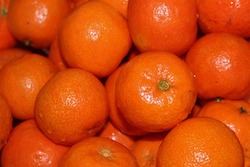Mandarin cultivation
4 October 2024
Mandarin cultivation
- Mandarin cultivation at home
- Mandarin cultivation in pots
- More tips for cultivating mandarins
- Mandarin cultivation requirements
- Specifics of citrus cultivation
See international announcements on Agro-Market24: Mandarin Price
Mandarin cultivation at home
Growing mandarins at home is a pleasant activity that allows you to enjoy fresh, homegrown fruits. To ensure that the mandarin tree grows well and bears fruit, it is essential to pay attention to a few key tips:
Choosing the right variety
Dwarf varieties of mandarins, such as Citrus reticulata or Citrus nobilis, are ideal for home cultivation, especially in pots. Disease-resistant varieties increase the chances of healthy growth and abundant yields.
Location and lighting
Mandarins require a lot of light. Place them in a well-lit spot, such as a window facing south. In winter, when the days are shorter, it may be necessary to supplement the plant with grow lights to provide at least 8-10 hours of light per day.
Temperature and humidity
Mandarins grow best at temperatures between 15-25°C. In winter, a cooler environment (10-15°C) encourages the plant to enter dormancy. Moderate humidity is crucial; in dry climates, it’s helpful to mist the leaves or use a humidifier.
Watering and fertilization
Mandarins should be watered regularly but not excessively. They prefer slightly moist soil but not waterlogged conditions. Overwatering can lead to root rot. During the growth and fruiting periods, use a fertilizer rich in potassium and nitrogen to support healthy fruiting.
Soil and pot selection
Mandarins prefer light, well-draining soil with a slightly acidic pH (5.5–6.5). The pot should have good drainage to avoid water stagnation around the roots, which can lead to rot.
Pest management
Home mandarin trees are susceptible to pests such as spider mites, aphids, and scale insects. Regular checks and treatments, both organic and chemical, will help keep the plant healthy.
Pruning and shaping
Pruning helps maintain the shape of the tree and encourages branching, leading to healthier growth and better fruiting. Regular pruning also improves air circulation, which can prevent fungal diseases.
Propagation
Mandarins can be propagated from seeds or cuttings, though cuttings from fruiting plants usually yield better results. Seeds should be fully mature and planted in well-draining soil.
Fruiting
With proper care, home mandarin trees can begin to bear fruit after a few years. Key factors for successful fruiting include adequate lighting, regular fertilization, and optimal growth conditions.
Mandarin cultivation in pots
Growing mandarins in pots allows for the possibility of moving the plant indoors during colder months. This is particularly important if you live in a cold climate. Choose dwarf varieties for the best results in container cultivation. Ensure that the pot is large enough for the roots and has good drainage to prevent waterlogging.
Optimal conditions for mandarins
Mandarins grow best at temperatures between 15-20°C. The soil should be slightly acidic and well-draining to avoid water accumulation, which can damage the roots. Adequate lighting is crucial for fruiting, especially in winter when the days are shorter.
Symptoms of nutrient deficiencies
Lack of essential nutrients can cause yellowing or leaf drop in mandarins. Regular fertilization with a balanced fertilizer ensures the plant receives everything it needs to produce healthy fruits. Pruning the tree can also help maintain nutrient balance and promote stronger growth.
Citrus pests
Like other citrus trees, mandarin trees are susceptible to pests such as spider mites, aphids, and scale insects. Regular inspections will help detect infestations early and allow for quick remediation. White flowers on the plant may also indicate the presence of pests, so regular observation of the plant is key to its health.
Propagation of mandarin trees
Mandarin trees can be propagated from seeds or cuttings. Cuttings from mature, fruiting trees yield better results. Seeds should be planted in well-draining soil and kept in a warm, humid environment to encourage germination.
More tips for cultivating mandarins
In addition to providing fresh, juicy fruits, mandarin trees serve as a decorative addition to the home. Their fragrant flowers and evergreen leaves bring a tropical feel. When growing mandarins in pots, make sure to monitor lighting and humidity throughout the year, especially in winter.
– Keep the soil slightly moist to prevent it from drying out.
– Seasonal changes and the angle of sunlight can affect plant growth, so move it if necessary.
– Yellowing leaves indicate a lack of iron, so consider supplementing the plant’s nutrients.
Mandarin cultivation requirements
Like other citrus trees, mandarins, such as common lemon (Citrus limon) or bitter orange (Citrus aurantium), require special care. These plants grow in warm climates and need full sun. Cultivating them in pots allows for greater control over growing conditions, but it also requires regular care to keep them healthy.
Growing mandarins at home is an extremely satisfying activity that allows you to enjoy ripe fruits in a domestic setting. Citrus plants, including mandarins, are among the most commonly grown citrus plants in pots. However, to achieve success in cultivating these fruit-bearing plants, attention must be paid to several key factors.
Specifics of citrus cultivation
Mandarins, like other citrus trees, such as common lemon and bitter orange, require special conditions for growth and fruiting. In their natural environment, these plants grow in warm climates, meaning that in our home conditions, they need a constant warm place with plenty of light. Growing citrus in pots allows for controlling their growing conditions but also requires systematic care.
Citrus plants need a substrate that is kept slightly moist but should avoid excess water, as overwatering can lead to root rot. It is also important for the citrus leaves to have access to light, so regularly rotating the pot around its axis will ensure even exposure to sunlight. Insufficient light can cause yellowing of the leaves and even their drop, which may indicate a nutrient deficiency or lack of iron.
 Contact
Contact








